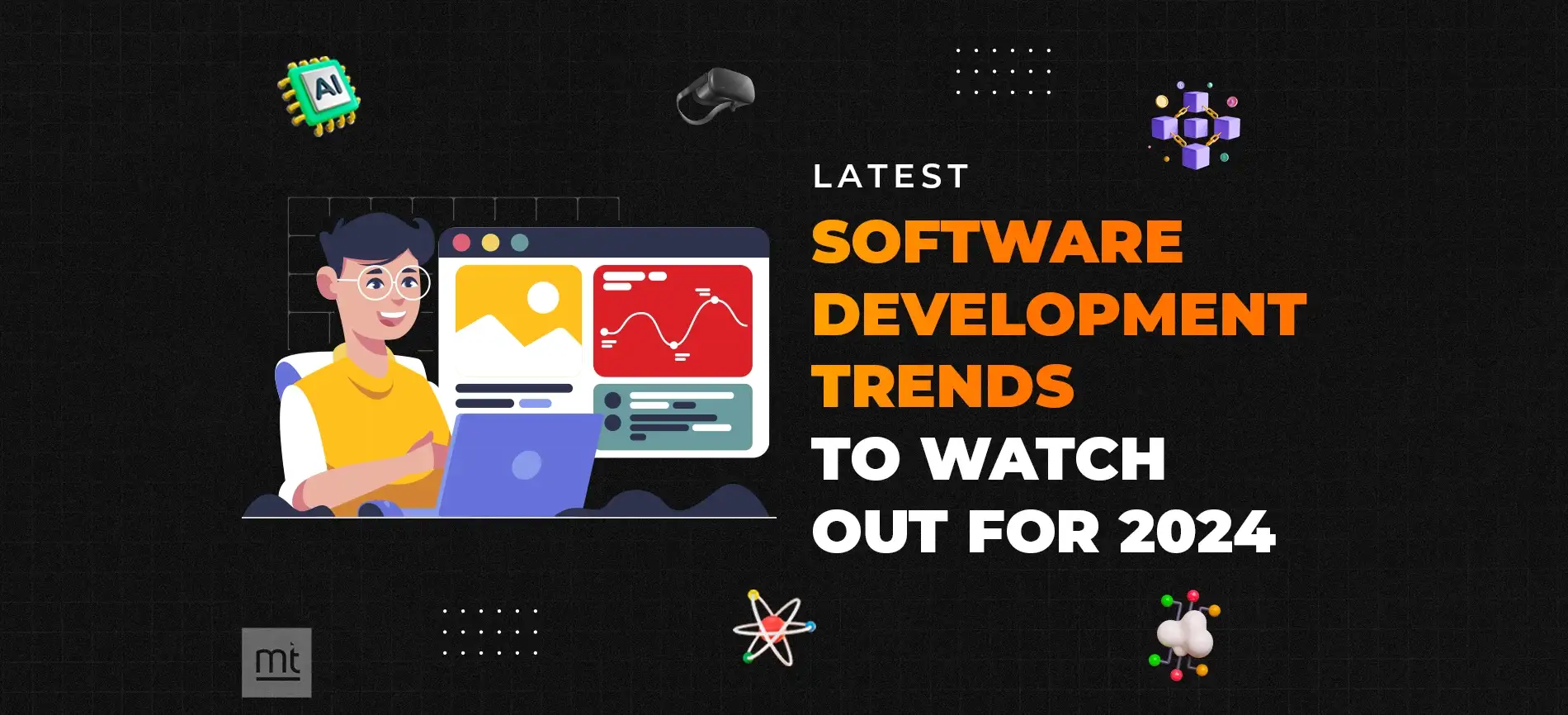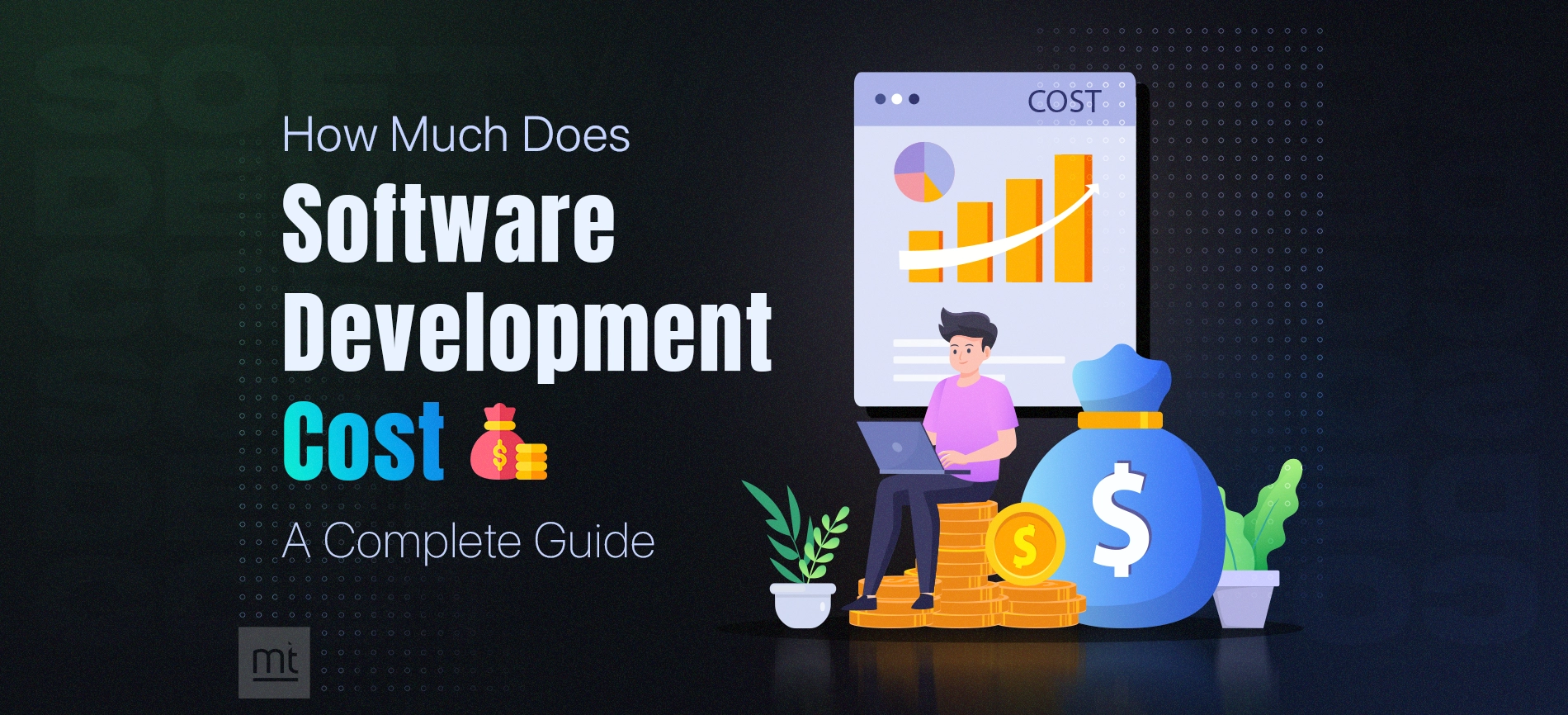Introduction:
In this smart world, everything now is linked with mobile phones and thus the demand for software development has increased drastically. This is because it enables businesses to compete effectively while providing solutions that customers want. The development of business-specific software helps startups and existing enterprises achieve better operational efficiency and scalability and improved customer interactions.
Whether you’re an entrepreneur with a groundbreaking idea or a company looking to enhance operations, developing softwares tailored to your needs can provide a significant advantage. A successful product launch depends on developers' ability to understand software creation together with their selection of suitable development methods and their handling of typical development issues.
This blog will help you understand the concept of software development, from ideation to launching the app. Let's begin
Key Software Development Statistics to Know
- A study showed that the worldwide developer population was grown to 28.7 million in 2024 as it increases by 3.2 million from 2020.
- The software development sector consumed 18% of total IT spending in 2022-2023 because organizations strongly pursued digital transformation.
- The adoption of cloud computing services reflects increased IT spending trends as cloud solutions now represent 16% of all IT investments.
- The market segment will generate US$740.90bn in revenue when 2025 arrives.
- Enterprise Software leads this market segment with US$315.00bn expected to be the market volume by 2025.
- The Software market revenue is predicted to grow at a consistent rate of 4.87% from 2025 until 2029.
- The market will experience significant expansion so that its total value will rise to US$896.20bn by 2029.
What is Software Development?
Software development represents the complete lifecycle which involves application design and coding while also including testing and deployment for solving business or consumer needs. The development process combines programming languages with frameworks and software development procedures to build applications that work across desktops and mobile devices and cloud platforms.
The software development process uses structured methodologies including Agile and Scrum and Waterfall to build dependable and scalable solutions efficiently. Many businesses team up with custom software development companies to create applications that fulfill their organization-specific requirements.
Types of Software Development
Different software development specialties serve separate business needs based on their technological specifications. The following list presents the five main software development categories along with their essential role.
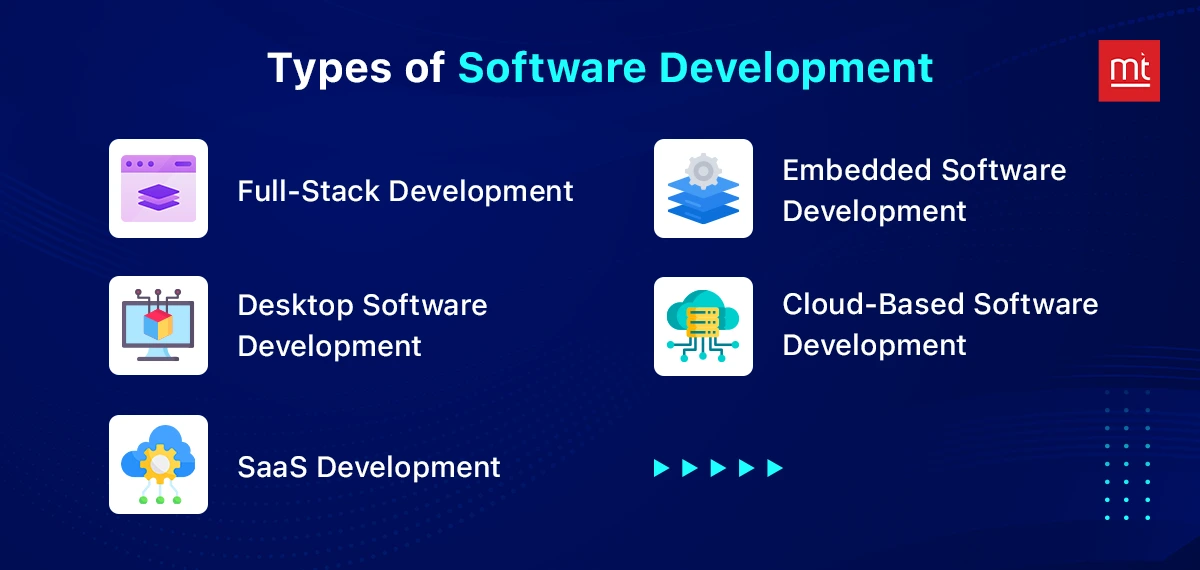
1. Full-Stack Development
A full-stack developer creates the complete software structure by building interfaces for users and implementing the server components along with databases and logical systems. Full-stack developers handle multiple technologies to achieve smooth integration & functional performance. Web and mobile applications benefit most from this development method because it gives businesses full control of their platform operations.
2. Desktop Software Development
The development of desktop applications targets programs that execute from computer hard drives instead of browser-based platforms. The target audience for these productivity tools along with design software and security applications uses this type of programming. Users can perform work offline on their computers through the dominant operating systems of Windows, macOS and Linux.
3. SaaS Development
Users can access SaaS applications through the cloud because Software as a Service (SaaS) development sends applications via web browsers. SaaS has become the preferred solution in business because it offers scalability and affordable pricing and continuous automatic software updates. The category includes Customer Relationship Management systems and project management tools and cloud-based accounting software among others.
4. Embedded Software Development
The functionality of embedded software exists specifically on purpose-built hardware devices which include the Internet of Things (IoT) devices and medical equipment and industrial machines. Such development remains essential to industries that need immediate data processing alongside automated systems. Embedded system design requires three fundamental aspects which include efficiency alongside reliability and minimal power usage.
5. Cloud-Based Software Development
Cloud-based software development creates applications which function exclusively from cloud environments to provide both remote access and data security and scalability capabilities. Organizations leverage cloud-based solutions to process big data, execute AI applications and manage ERP systems for improved business productivity and workplace cooperation.
Why Software Development is Essential for Modern Businesses?
The modern digital environment forces businesses to depend on software development so they can optimize operations and deliver better customer experiences and maintain competitive advantage. Software solutions that match business needs can fundamentally change operational methods in a business through automation and security improvements.
Saves Time and Boosts Productivity
Custom software solutions use automation to handle regular tasks which eliminates human work and decreases human errors. Team members can work on essential tasks because of this which results in accelerated processes and superior outcomes.
Improves Customer Experience
The right design of software applications enables businesses to deliver personalized customer experiences and quick support at every interaction thus building stronger customer trust.
Gives Businesses a Competitive Edge
Businesses achieve competitive advantage through customized software because it enables them to deliver exclusive features as well as enhance operational efficiency and generate strategic insights.
Grows with Your Business
The implementation of good software development provides businesses with the ability to scale their operations and introduce new features alongside market adaptation without complete rebuilding.
Keeps Data Secure
Strong software security measures protect sensitive business and customer data while ensuring compliance with industry regulations because of increasing cybersecurity threats.
Top Challenges When Developing Software
When initiating software to develop a business idea is an exciting journey, but it comes with challenges. Here are some key challenges in developing software and how they impact the process.
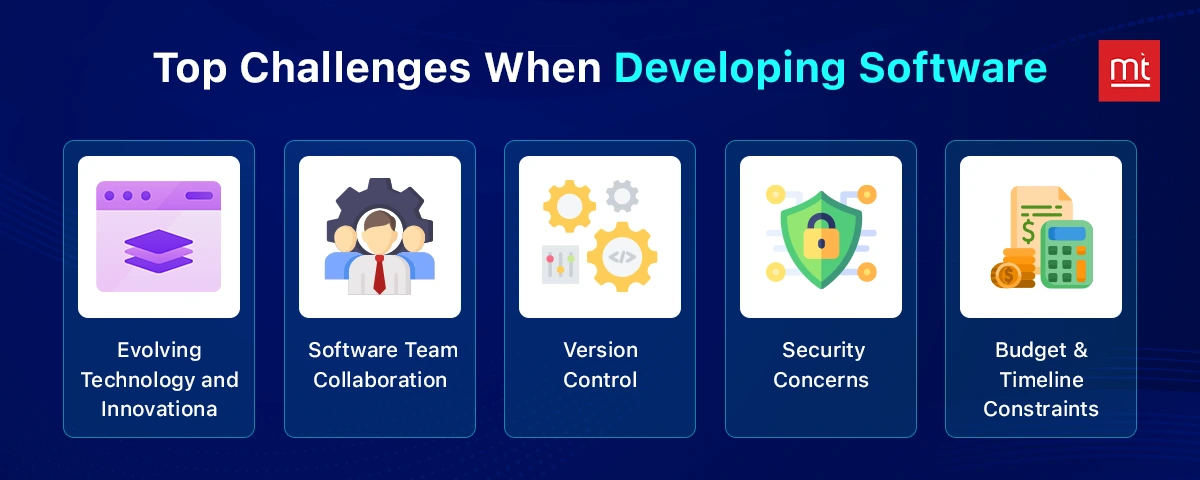
#1. Evolving Technology and Innovation
Fast-moving technology creates challenges for businesses to select appropriate tools needed for software to develop. To maintain competitive advantage businesses need to monitor AI alongside cloud computing and automation trends to develop software that stands for the future.
#2. Software Team Collaboration
One of the biggest challenges software development processes face is team collaboration. This is because software development isn't about adding features and integrating functionality, it also includes designing, user-friendliness and lots of monitoring which involves different teams. When teams lack clear communication the result becomes vague, dissatisfied and delayed work and fewer efficiency points which makes it more challenging to achieve products that meet business targets.
#3. Version Control
Before beginning the development of software, the custom software development company should discuss the purpose, features, client requirements and everything regarding the software with all the involved team members. This is important to avoid the risk of code overwrites and update loss while producing inconsistent software. Team projects become more stable through project stability by using Git tools to track changes which helps maintain project stability in how to Develop Software effectively.
#4. Security Concerns
When you build software, you need to pay extra time and attention to its security because jewelry without a locker is an invitation for thieves. Similarly, building software which deals with sensitive data requires immediate attention to cybersecurity challenges. The protection of user information together with trust maintenance depends on strong encryption and secure authentication systems and regular security testing.
#5. Budget & Timeline Constraints
Software development projects often experience budgetary increases and timeframe delays during the process of software creation. The cost increases because of inadequate planning along with scope expansion and unexpected obstacles thus requiring the establishment of practical timeframes and strategic resource distribution.
Software Development Life Cycle (SDLC) Phases
All software development projects need to follow the formalized process of Software Development Life Cycle (SDLC) to achieve success. A methodical process enables both minimal risk reduction and efficient outcomes as well as superior product quality. Understanding these phases helps both new developers learn software creation techniques and experienced developers improve their existing processes to achieve project success.
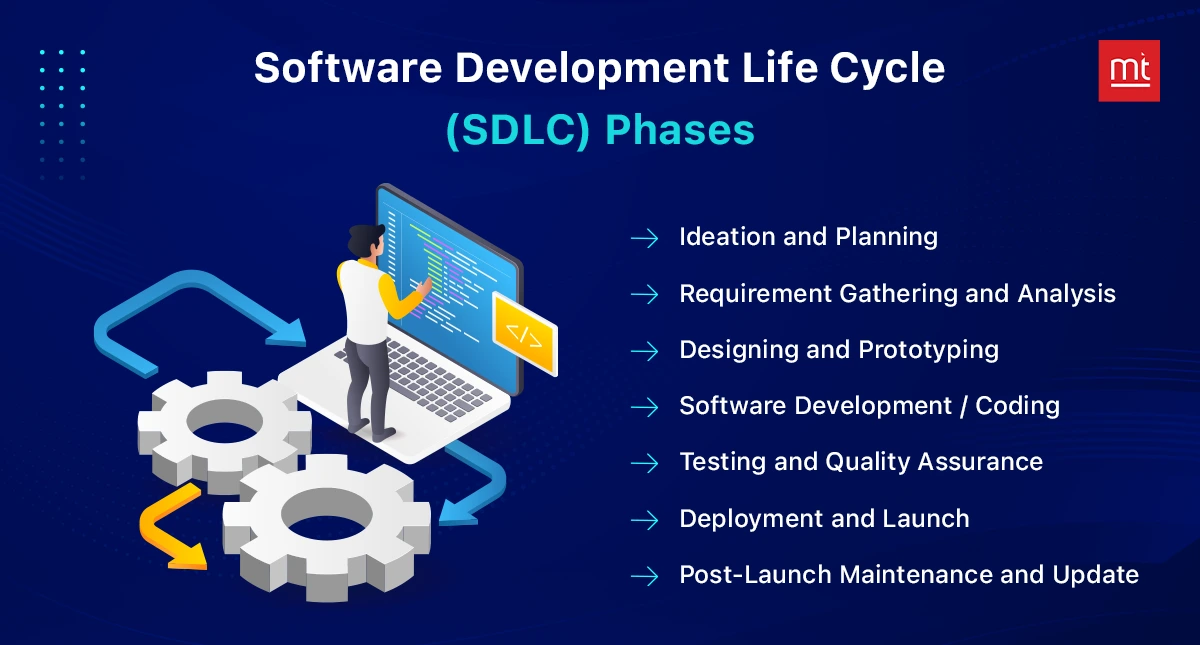
Phase 1: Ideation and Planning
The first essential aspect of software creation involves developing the concept alongside specific goals and performing market research. The solution brainstorming and target user identification and roadmap development process takes place during this phase. The software development process maintains user requirements and business targets through proper advance planning which avoids upcoming development issues.
Phase 2: Requirement Gathering and Analysis
The effectiveness of software development depends heavily on determining the necessary functions of the software. The definition of functional along with technical requirements occurs through joint efforts between developers and stakeholders and business analysts. The documentation process verifies that each feature along with integration points and security components receives proper documentation for design and development activities.
Phase 3: Designing and Prototyping
The development process requires a properly organized design system to achieve smooth software development. The design phase concentrates on building system architecture and user interface and user experience elements and developing wireframes and prototypes. Prototyping enables developers to create visual representations of the end product thus collecting feedback from users which helps make the software more intuitive and user-friendly before writing code.
Phase 4: Software Development / Coding
The development of actual programming software occurs at this stage. Programmers transform architectural requirements into functional code through the selection of appropriate programming tools for project-based development. Drafting the software requires following established standards for coding while maintaining version control and performing regular testing to achieve an error-free error-free development procedure.
Phase 5: Testing and Quality Assurance
There is no point in developing a fantastic software if testing is not given utmost importance. Software testing ensures all the issues, bugs and troubles are fixed before launching the software. The QA teams use functional security performance and user acceptance testing to uncover and resolve bugs in the system. Testing approaches that combine manual and automated methods verify that software satisfies its deployment requirements.
Phase 6: Deployment and Launch
Once the software qualifies the testing phase, it's time to deploy the changes and prepare it for end users. A successful software development plan requires businesses to execute a seamless launch that avoids system downtime. The deployment process includes beta testing, cloud implementation for smooth and uninterrupted performance and resolving emerging problems.
Phase 7: Post-Launch Maintenance and Update
Post-launch activities are essential because regular updates together with bug fixes and performance optimizations become critical elements for enduring business success. Organizations need to check user feedback while implementing security updates and adding new features to maintain their software development efficiency and market compatibility.
SDLC Models & Methodologies
The selection of an appropriate software development process model stands as a key requirement for constructing dependable and scalable and efficient software. Different development methodologies deliver organized methods to build software which enables successful project completion during the entire development lifecycle. There exist multiple SDLC models which serve various business requirements and these models are presented below.
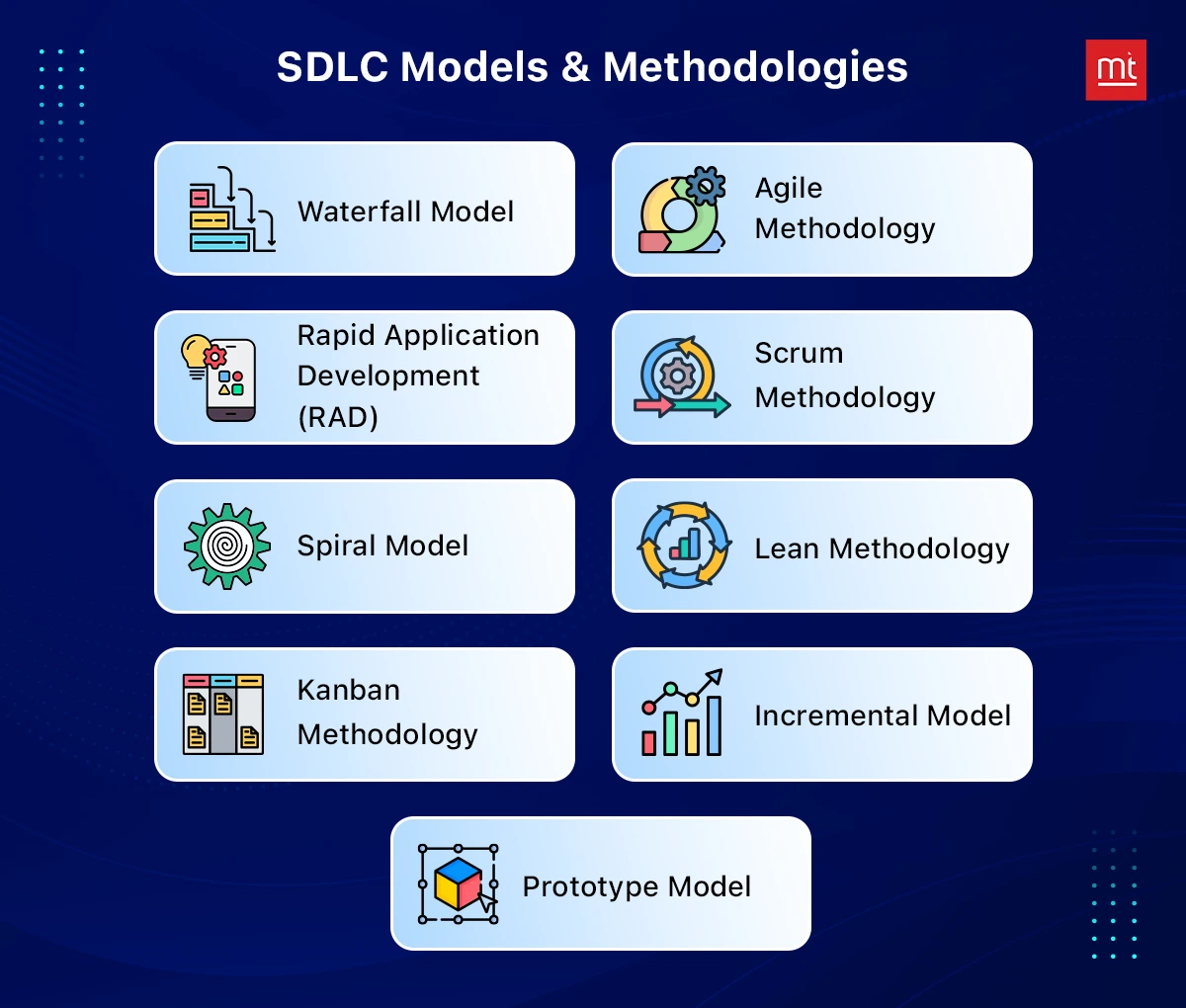
#1. Waterfall Model
In the Waterfall Model developers must finish each stage in sequence before moving to the next step. The waterfall model works best when projects have well-defined requirements that need to be implemented in government or banking systems. Its strict structure limits its effectiveness when dealing with software development requirements that change frequently.
#2. Agile Methodology
Agile functions as a versatile development approach which divides work into multiple small segments known as sprints. The method promotes continuous interaction between developers which leads to frequent feedback loops that drive improvements thus making it popular for contemporary software development organizations. The Agile method serves businesses that must develop software through adaptable approaches to changing project requirements.
#3. RAD (Rapid Application Development)
The Rapid Application Development method selects rapid prototyping together with continuous feedback instead of extensive planning. The method enables teams to build operational prototypes swiftly which makes it suitable for both new businesses and established companies seeking software to develop through user-focused approaches. RAD serves as the preferred method for developing projects which need fast market entry.
#4. Scrum Methodology
Through Scrum as an Agile framework developers split their work into brief sprints to build team cohesion while making steady development advancements. The methodology includes short daily meetings for better team communication and obstacle detection. Scrum serves as the primary framework for custom software development companies to produce high-performance scalable software in an efficient manner.
#5. Spiral Model
The Spiral Model connects iterative development to risk assessment through every development stage. The model works best for demanding or high-risk projects that experience regular requirement modifications. Large-scale systems in the USA require continuous refinement through the use of this model by software development companies.
#6. Lean Methodology
Through the approach of Lean businesses remove wasted resources and achieve better efficiency by removing unneeded processes. The development methodology stands out because it delivers fast results at low costs while maintaining high-quality output so bespoke software development services use it frequently. Lean methodology suits businesses which need to optimize their software development process using minimal resources.
#7. Kanban Methodology
Visual tracking systems based on Kanban enable project teams to better monitor their work through transparent boards. Real-time progress tracking through this system enables teams to maintain smooth operations in software outsourcing services. Kanban serves as a popular method for continuous delivery and maintenance projects because it provides flexible working capabilities.
#8. Incremental Model
The Incremental Model divides software development into smaller parts to perform individual testing and refinement before modules merge. This model provides superior quality results and lower risk which makes it an appropriate method for companies that need software developers to execute projects step by step.
#9. Prototype Model
The Prototype Model produces an operational software prototype which helps users provide feedback ahead of complete software development. Startups along with businesses benefit from this approach because they require software development services to improve their product concept before starting complete development.
Software Outsourcing
Software outsourcing is a business practice by which companies delegate the development work of the software to the external teams that they do not employ. This way, businesses can get rid of the expenses, work with global talent, and speed up the timeline of the project. The diversity in the model of outsourcing makes it easier for the company to find the most appropriate solution for its development project needs.
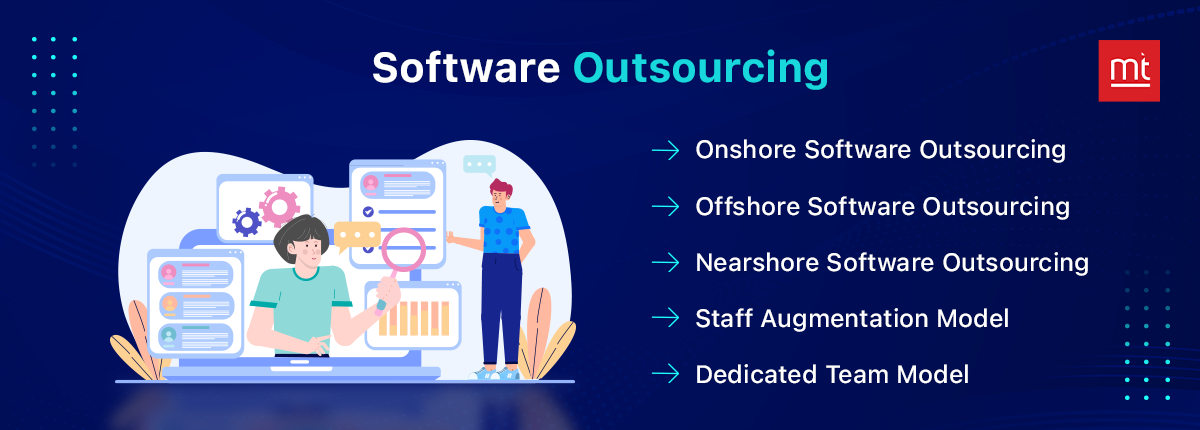
1. Onshore Software Outsourcing
Onshore outsourcing is a situation where a software development company is hired from the same country as the organization. This alternative to remote work is particularly suitable for the instance when there are no language and time zone differences. It is not the main option, because only in places with expensive labor will it be more expensive, even though the quality is good.
2. Offshore Software Outsourcing
Offshore outsourcing is a practice of partnering with a dedicated custom software development company in USA often in pursuit of cost savings. The business gets the advantage of talent from around the world, and having teams besides the main time zones, this means that projects can be worked on 24 hours a day thus speeding up the development.
3. Nearshore Software Outsourcing
Nearshore outsourcing is a practice of working with a software development company in the USA or in the region with similar time zones. The advantage of nearshore outsourcing stands for a balance of cost and collaboration benefits, providing better communication than offshore outsourcing while keeping a reasonable amount of money as opposed to onshore teams.
4. Staff Augmentation Model
In this method, companies hire software developers to come in as an extension of their in-house team. It is a development strategy that allows companies to allocate their resources based on the project’s needs meanwhile, keeping control of the development through flexible staffing which makes it a more cost-effective solution than a regular hiring.
5. Dedicated Team Model
The dedicated team model is a service where the whole team is hired externally to facilitate specific projects of a company or long-term development requirements. This strategy is really popular among the companies that provide custom software development services, besides, it ensures the needed expertise, the development efficiency, and the communication without adding the unneeded extra cost in the management.
Cost of Building a Software From Scratch
Software development cost differs according to the level of complexity, features, and the technology stack.
- A small app will cost between $10,000 and $50,000 while a mid-range one goes from $50,000 to $200,000.
- The cost of complex software for businesses to develop can be higher than $500,000.
The visual part of the design, the back-end structure, security, and the connections with other services are the factors which all affect the cost of a product. Besides, whether it is a custom software development company or software outsourcing services, the cost will go up accordingly.
Agile methodologies support the maintenance of budgets and their scaling up. In order to get an authentic quote, businesses need to describe the requirements, select the proper development process, and be prepared for the after-launch-checks. A proper budget plan makes the whole project go smoothly and helps achieve long-term success.
Why Partner with ManekTech as Your Startup Software Development Company?
Expertise in Startup-Centric Development
ManekTech has become a recognized software development brand for startups, providing customized solutions that best align with the business' goals. They have relevant experience in developing innovative and reliable software, thereby startups feel secure to build, launch, and expand their business.
Expertise in Emerging Technologies
Our team utilizes cutting-edge technologies including AI, blockchain, and cloud computing empowers startups to lead the market. Their strength in the software development process guarantees that your product has the best qualities and that it's ready to be used in the coming years.
Comprehensive Support from Idea to Launch and Beyond
From the initiation of business plans to the submitting of the final product in the market, ManekTech offers a complete software development package. Their team is responsible for the whole development process, from UI/UX design to the final step of deployment, and the maintenance of the product.
Agile Development for Faster Time to Market
We at ManekTech adhere to the Agile methodology which supports startups with the opportunity to develop software in the most efficient way with iterative releases. This method gives scope to integration of customer's feedback effectively, reduction in development cycles, and the ability to coordinate market demands logically.
A Proven Track Record of Successful Startup Partnerships
ManekTech's portfolio of startup projects that are accomplished has ended up being a live example used in the development of various businesses and their software. Their promise to excellent delivery and enhancement has made them the top pick for the trusted custom software development company.
Seamless Communication and Project Management
ManekTech makes collaboration a seamless process through clear communication and a well-organized and defined project management structure. Our customer-driven project management approach, provided by experienced software development experts plays an excellent role in the efficient, on-time, and hassle free delivery of the product.
Conclusion
Developing softwares is a lasting decision that comes out of pooling innovation, efficiency, and growth. Whether you are customizing a solution or using software development services, a knowledge of the software development process is crucial to the project's success. Solving problems, picking the right SDLC model, and independent software vendors are just three of the ways to get the development process in order and the costs down.
The right approach is the path to creating software that satisfies the business objectives and remains competitive in a market that is evolving. You are now ready to transform your concept into a product!
About Author
Subscribe to Our Newsletter!
Join us to stay updated with our latest blog updates, marketing tips, service tips, trends, news and announcements!


